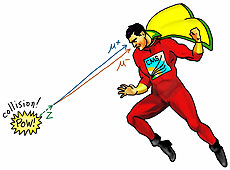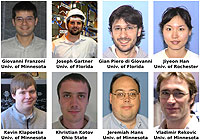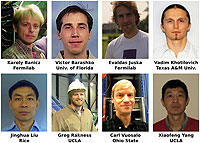Z-ray vision
 |
| Z bosons are identified by the particles that they decay into (μ+ and μ− in this case). Then, the Z bosons are used to study the collision that made them.
|
All of the matter and energy of our everyday experience is made of only five basic particles: electrons, up and down quarks, gluons to glue the quarks together and photons, which are particles of light. This is just a corner of the particle landscape as we currently know it: including these five, 29 different types of fundamental particles and antiparticles are routinely produced in high-energy collisions. Some of the others are antimatter, some immediately decay, and some interact so weakly with normal matter that they disappear from view, leaving those that make up our material world.
One of these unfamiliar particles is the Z boson, a high-energy analogue of the photon. Whereas a photon is massless and stable, a Z boson is very heavy and decays within a trillionth of a trillionth of a second. Yet the two are twin aspects of the same electroweak force. Processes that produce photons also produce Z bosons, if they have enough energy to create the Z particles' large mass.
The high energy of collisions in the LHC is sufficient to produce Z bosons in abundance. Compared to the handful of Z particles observed at the time of their discovery in 1983, the LHC at peak luminosity produces millions of them per day. The flashes of impact in the LHC are approximately as bright in Z-light as they are in ordinary light.
In a recent paper, CMS scientists analyzed the angular distribution and energy spectrum of Z bosons emerging from these collisions. These distributions provide a view of the first instant of collision since Z bosons are unaffected by all of the other particles in the collision debris.
If this sounds familiar, there's a good reason. An article two months ago presented the same kind of study using photons instead of Z bosons. The energy spectrum, or color, of the light emerging from the collisions provides an early snapshot of the interaction because light also streams out unaffected by the other particles.
Thirty years ago, the Z boson was an exotic, theoretical particle. Today, it is a new pair of eyes to reach deeper into the microcosm.
—Jim Pivarski
 |
|
The U.S. physicists pictured above played an important role in this analysis, as part of an international collaboration.
|
 |
|
These physicists are responsible for the system that identifies and records muons passing through the CMS endcap, which makes this kind of Z boson decay visible.
|
|